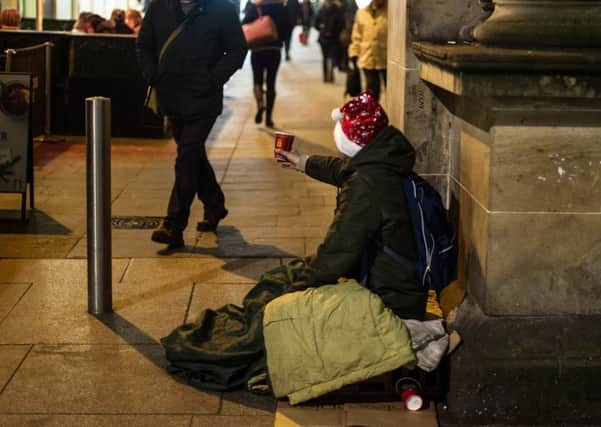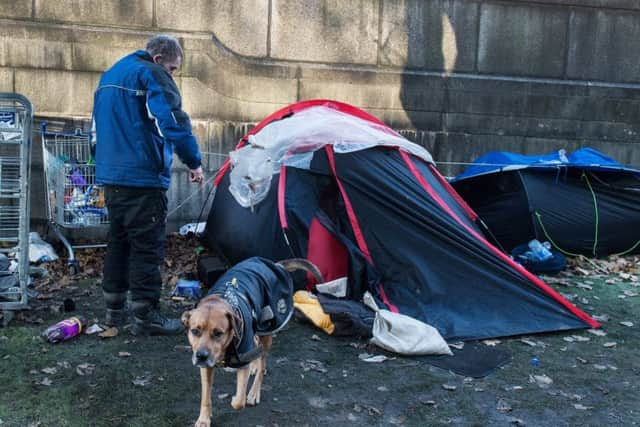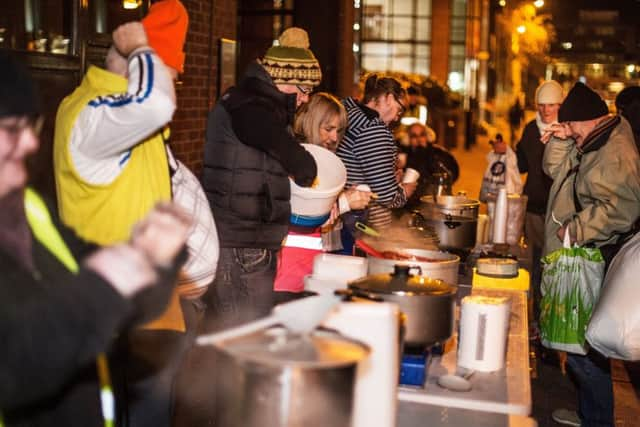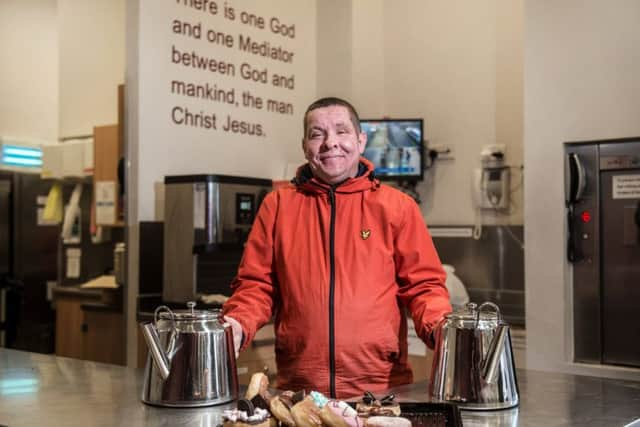Insight: Scotland's street sleeping crisis


There, behind the Museum of Modern Art – a Santa hat on his head – sits Iain, one of the city’s rough sleepers. Like many of those on the streets, Iain has spent a lifetime drifting in and out of homelessness. Born into a dysfunctional family, he spent much of his childhood in foster care and left home at 16; depressed since adolescence, he struggles with addiction issues and is caught in a seemingly endless cycle of prison, B&B accommodation and dossing in doorways.
Tomorrow, Iain hopes to get into a hostel on Clyde Place, but tonight, he will take his sleeping bag and head along to tunnels underneath the Glasgow Royal Infirmary where he will courie down in the hopes of stealing some warmth from the pipes.
Advertisement
Hide AdAdvertisement
Hide Ad“It’s rat-infested and it stinks of pish,” he says. “When I close my eyes, I hope I will never open them again. I don’t mean to upset you, but that’s the truth. When I wake up it’s devastation. Groundhog day. Just having to go through it again.”


I am walking through the city in the company of Thomas Hobbs, a member of the Simon Community’s Rough Sleeper and Vulnerable People street team, which provides a vital service to those who have slipped through society’s frayed safety net.
On every street, he stops and talks to chittering men and women, calling them by name, checking if they are OK and trying to persuade them to seek help for their addictions. Hobbs, who was once homeless himself, understands their needs: in his backpack, he carries clean works to keep those injecting safe.
At this time of the day, the priority is to try to get everyone indoors; but, even when the night shelter opens in a few days’ time, there will be those who refuse to leave their pitch or be parted from their dogs. Every year, some will freeze to death, so later Hobbs, or another member of the team, will return with sleeping bags.
Near Central Station, we meet David – out of prison and clean for several years – who has been sleeping on his brother’s couch. David’s main ambition is to keep away from the Bellgrove – a notorious private hostel where men are sometimes found lying comatose on the stairs. “If I went to the Bellgrove it would be like going back to prison again,” he says. “I would know everyone and they would all be on drugs. It would be a trigger to me to start using again.”


And a bit further along, there is Steven, 45, a former painter and decorator, fresh out of hospital with Strep A, with no more veins left to inject into. Tomorrow, Steven is going to go to a clinic and ask to be put on methadone. But tonight, he may sleep down by the Clyde and the chances are he will inject again. Aware his hospital stay will have made him susceptible to an overdose, Hobbs gives him an antidote – Naloxone – just in case.
For more than a decade, rough sleeping had been virtually wiped out in Scotland; a combination of pioneering legislation, increased rights and the setting of tough targets had led to a reduction in the number of people living on the streets. But in the past 12 months, the numbers have risen again. Even accepting that a proportion of those begging in Glasgow, Edinburgh and Aberdeen have a flat to go home to, there is no disguising the need and desperation. Although overall homelessness in Scotland is stable, the length of time people are stuck in temporary accommodation waiting for a permanent home is also growing.
The reasons for this are complicated: welfare reforms have hit hard, the Right to Buy policy has eroded the social housing stock, councils are facing cutbacks and – arguably – the Scottish Government has taken its foot off the pedal.
Advertisement
Hide AdAdvertisement
Hide AdA recent study carried out by researchers at Heriot-Watt University predicted that if economic policies continued unchanged, the number of rough sleepers would double from 800 to 1,500 in the next 25 years.


Now, at last, it seems homelessness is being pushed back up the political agenda. Earlier this year, the Scottish Government – which has abolished the Right to Buy and pledged to build 50,000 new affordable homes by 2021 (35,000 of them social rented) – set up a £50m fund and an Action Group aimed at eradicating homelessness.
And next weekend, almost 9,000 people, including Deputy First Minister John Swinney, will take part in the world’s largest sleepout in Princes Street Gardens. The event, organised by the Social Bite, hopes to raise £4m. But money is only part of the equation. It is also about creating a mass movement capable of eradicating homelessness within five years.
“If you are going to make an impact on an issue like homelessness it requires collaboration, so we have gone to every segment of society – churches, high schools, universities, corporate companies, the chief executives of financial institutions, senior figures from the Scottish Government – and asked them to support us,” says Social Bite founder Josh Littlejohn.
“Now I feel we are at some kind of crossroads. The Scottish Government’s commitment to give £50m over five years was way over and above the expectation of anyone in the homelessness sector, but we have also been working to bring the leadership of the councils and the chief executives of the largest housing associations on board.


“If you look at the actual statistics for core homelessness [defined as rough sleepers, people in refuges and B&B accommodation and those who are sofa surfing] it’s 4,500 individuals in our four largest cities and 11,000 households across Scotland. That’s not a huge number. When you look at the momentum and the level of commitment, it really ought to be solvable.”
In its early years, the Scottish Parliament passed some radical pieces of legislation aimed at bolstering the rights of individuals and reducing homelessness. In particular, the Homelessness etc (Scotland) Act 2003, required all local authorities to draw up homelessness strategies, forced registered social landlords to participate in rehousing homeless families and set out a timetable for the abolition of “priority need”, meaning that by 2012 all unintentionally homeless people would have an equal right to be rehoused.
With the target for eradicating homelessness set at 2012, local authorities too were focused on the problem; in Glasgow, for instance, there was a move to decommission the three council-run hostels – Peter McCann House, Robertson House and James Duncan House – where large numbers of troubled men and women were accommodated en masse, and replace them with smaller units with on-site support for their addiction and mental health problems.
Advertisement
Hide AdAdvertisement
Hide AdMany smaller units are functioning successfully today. The Mungo Foundation, for example, runs a variety of supported accommodation, including Fairstart for single homeless women, De Paul House, for young people who have been in care, and Stravaig, which provides emergency accommodation for young people excluded from other facilities.
But such units are generally over-subscribed, so many people still find themselves in private hostels, B&Bs (which require them to stay out all day) or on the street.
Lots of charities have redoubled their efforts in the face of growing need. Every Thursday night, volunteers from Help 4 the Homeless can be found setting up their soup kitchen on Glasgow’s Cadogan Street. Established by Melody Whitley and a friend three years ago, the group has grown from an ad hoc venture handing out some sandwiches to a major operation. When I arrive at 7.30pm, pre-cooked stews, curries and rice are being heated on 12 gas stoves and a long queue is already forming. “The very first week we came out, a very vulnerable man turned up – I looked for him the next week and was told he had died,” says Whitley. “It made me determined to keep going. Over the time we have been doing this, the need has grown massively. Now we serve 300 hot meals and around 100 hot dogs a night, and there is never anything left over.”


Some of the organisations that do frontline work have religious roots and a religious ethos; on top of their year-round work with homeless people, the Bethany Christian Trust in Edinburgh and Glasgow City Mission run the winter night shelters in their respective cities.
At the Glasgow City Mission, a mural of a Che Guevara Christ casts a benign eye over the ground-floor café where half a dozen men are enjoying a cooked lunch and a cup of tea. The building, on Crimea Street, is spread over four storeys and includes, among other things, a women’s lounge, an activities room (with computers, a music studio, a gym and arts and crafts) and a small roof terrace.
In the evenings, the mission focuses on serving food and developing relationships with those who come through its doors. During the day, however, it helps those who are ready to move on in their lives gain the stability and skills necessary to sustain a tenancy and get a job. Many of those who volunteer there started out as “guests” or service users.
That’s what happened to Craig McDonald. Born to alcoholic parents, the 38-year-old dodged school and started abusing drink and drugs in his teens; when he was drunk or high, he would lash out, so at 18, he was thrown out of the house.
Like Iain, he did the round of hostels and B&Bs, but soon he was “DNA-ed” (Do Not Accommodate) almost everywhere and so spent more and more time on the streets. He reached rock bottom when a friend died of a drugs overdose; weighing six stone and covered in abscesses, he spent 16 months in a residential Christian rehab unit called The Haven. Since leaving eight months ago, he has stayed clean; he helps at the City Mission and is now doing some paid work when the Hamish Allan centre (which processes homeless applications) holds sessions in the building. Better still, McDonald was recently given the keys to his own home. “It’s a responsibility because every flat I’ve had before, it’s been a riot, a den – but life is really different now,” he says.
Advertisement
Hide AdAdvertisement
Hide AdGraham Steven, partnerships and communications manager at the City Mission, says the definition of success depends on the individual. “For some people [like McDonald] it’s a tangible thing like a house or a job or a training course, but for others it could just be getting out of bed that morning and wanting to live again that day.
“If people come to us, it is because they have fallen through the gaps of a system that works for the majority but not for all. The way we are funded and structured allows us to keep journeying with people as long as is necessary.”
But why are so many people falling through the gaps? And why are charities being left to pick up the pieces? The answer varies from city to city. In Edinburgh, there is a lack of available accommodation. In Glasgow, there seems to be a problem with the way those presenting as homeless at assessment centres are dealt with. “We are finding there are three main hurdles people face,” says Lorna Walker, legal service manager for the Govan Law Centre’s prevention of homelessness team. “The first is that they are not being allowed to make a homelessness application; the second is that when they do make a homelessness application, the council is not offering them temporary accommodation [as it is obliged to do], and the third is that people who are offered temporary accommodation often end up staying there for months, sometimes years.” Sometimes, the Govan Law Centre will threaten to take the council to court in order to galvanise it into action.
In a bid to tackle some of these issues, Glasgow City Council is moving away from assessment centres towards a multi-agency hub where those who present as homeless can access all the services they require under one roof. It has also set up a rough sleepers task force which is reviewing the city’s homelessness strategy, consulting those with “lived experience” and looking at the protocol under which people are banned from temporary accommodation.
Last week, too, the national Action Group issued a series of practical recommendations, such as the expansion of the Edinburgh night shelter and an increase in the outreach capacity in Glasgow, Edinburgh and Aberdeen. It also suggested a shift towards a “name lists” policy which means all the relevant agencies sitting round the same table talking about the specific needs of individual rough sleepers.
The most radical shift, however, is the move towards “Housing First”, a policy that has proved successful in North America and Scandinavia. Until now, people who have experienced repeat homelessness have been expected to work their way up from hostels and B&Bs to permanent accommodation.
Housing First turns this on its head. It works on the premise that even those with the most chaotic lifestyles should be given a mainstream home and wrap-around support to help them to keep it. The logic is that only when people have a measure of stability can they begin to tackle addiction and mental health issues.
Several years ago, Turning Point in Glasgow ran a pilot project in which 22 drug users were housed in independent housing association flats. The project was staffed by a six-strong team which included three peer support workers. Over the three years, there were no evictions and all but two of those involved maintained their tenancies.
Advertisement
Hide AdAdvertisement
Hide AdThere are now Housing First projects running in seven Scottish councils with more expected to follow soon. For the first time, Glasgow City Mission has taken on 10 houses to accommodate some of the city’s most chaotic homeless people, with the tenants expected to be in by Christmas.
Many charities hope their efforts will prompt local authorities, housing associations and the Scottish Government to throw their weight behind the strategy. It is understood several local authorities have been looking at how much social housing could be given over to Housing First and that “game-changing” announcements on this front will be made on the night of the sleepout.
“We did a feasibility study taking the whole of the Liverpool City region and looking at how you would need to reconfigure the commissioning system to make Housing First work,” says Jon Sparkes, chief executive of Crisis and the chair of the Action Group. “What we found is that if you minimise the use of emergency and temporary accommodation and maximise the opportunities to rehouse people quickly, over the medium term the costs are less.
“But it’s also more effective. People will go round and round the hostel system and just 15 per cent of them will go on to sustain tenancies, whereas with Housing First the sustainment figure is around 85-90 per cent.”
Back in Glasgow, another rough sleeper, Sean, is still going round and round the system. He has arrived back at his “skipper” – the canopied entrance of an empty building next to the Grosvenor Casino on Glassford Street – to find his partner Lizzie dozing under their sleeping bag; she wakes up, crankily, and then sits hunched, her face screwed up against the cold.
Now 32, Sean was taken into care as a toddler; when he was 17, his attempts to forge a relationship with his mother failed and he ended up on the streets.
“The thing about B&Bs is there is no privacy, little safety and a lot of rules,” he says. “The owners will go through your belongings and sometimes things will go missing. If we had our own flat, maybe we would have a better chance of getting off drugs.”
Sean and Lizzie are often the targets of abuse. “People shout at us, spit on us, sometimes urinate on us,” he says. “One day some women started hurling their high heels at the sleeping bag to see if there was anyone inside.”
Advertisement
Hide AdAdvertisement
Hide AdBut equally people are capable of great acts of kindness. The red jacket Sean is wearing was a gift from a passer-by who took it off his own back. While I am with him, a taxi draws up and a customer jumps out and thrusts a £5 note in his hand before heading off into the night. A few moments later, a woman arrives with a small parcel of hot food.
That impulse to help will be writ large on Saturday as people gather to show solidarity and raise funds. With so much momentum, it does feel as if this is an opportunity that must be seized. “These people [rough sleepers] are easily overlooked. Homelessness is not a big vote-winning issue,” says Littlejohn. “One of the big objectives of the sleepout is to change all that: to make these voiceless people impossible to ignore.”